You’ve seen their posts on social media…
Bloggers boasting about their seven-figure businesses, telling you how much they love their work, their clients, and their lives.
They tell the tales of their premium professional coaching packages and the waiting list of clients eager to whip out their credit card.
It seems like an awesome gig, and you’d love a coaching business of your own, but these posts frustrate the hell out of you. Because you’re nowhere near where those guys are.
They have built their blogs. They have built their brands. They have built their audiences. All they need to do to get new clients is send an email to their thousands of subscribers.
But you? You’re just getting started.
Nobody knows who you are, you barely have an audience and, frankly, you barely have a blog. You’re nowhere near ready to launch into coaching … right?
Wrong. And here’s why …

You Don’t Need Thousands of Subscribers to Start Your Coaching Biz
Yes, having an established blog with a huge audience is a major boon to anyone’s coaching business. People will recognize you as a credible expert, and you’ll have hordes of potential clients to pick from.
It makes the whole process of getting clients a whole lot easier and less time-consuming.
But that doesn’t mean you need to wait until you’ve amassed 5,000, 1,000, or even 500 subscribers before you start coaching.
You can start coaching right now, even if you don’t have ten subscribers on your list yet.
And you should start right now.
You know blogging will boost your coaching service, but what you may not know is that coaching will boost your blogging efforts as well.
It will provide insights into your target audience that you wouldn’t have had otherwise. This will position you to create more relevant content that connects with them on a deeper level.
Even if you need to give your first few sessions for free, the sooner you get in touch with your audience, the better.
You won’t just get to know them better, you’ll also get the case studies and testimonials that will help sell your coaching package down the line. (Not to mention the confidence.)
Convinced yet?
Good. Then you must be wondering how you’re supposed to get clients.
Let’s dig in…
Want to Know How to Get Coaching Clients? Here are 10 Proven Ways to Get Your First Paying Client (Even if You’re Starting from Scratch)
- Put Yourself on a Stage
- Rub Shoulders at Relevant Events
- Woo Potential Clients on the Phone
- Enlist Friends and Family as Wingmen
- Tap into Your Business Network
- Email Your List (Even if it’s Tiny)
- Write the “Ultimate” Ultimate Guide
- Show Your Expertise in Relevant Facebook Groups
- Step in Front of the Camera
- Run a Lottery for Freebie Sessions
Getting your first paying coaching client may seem like a daunting task. But it doesn’t have to be. Others who have stood in your shoes have already tried and tested numerous methods and learned which ones work best.
No need to recreate the wheel or waste energy trying to discover it on your own.
I checked in with a number of successful coaches from a variety of industries on what they did to win their first coaching clients. I also asked them, if they had to start all over again, what they would do today to win their first client based upon everything they’ve learned.
Their responses were overwhelmingly similar. In fact, most felt so strongly about how well their method worked, they would use it again if they had to start from scratch.
Some of their methods are online, but others are old-school and will require you to leverage offline tactics. (Imagine that!)
Pick one or two options that make sense for your personality, your situation, and your ideal customer. And then go get that client!
1. Put Yourself on a Stage
A smart way to get people to recognize your expertise is to put it on a stage where they can see it in plain view.
It doesn’t matter how much experience you have. Anytime you put yourself in front of a group of people, either as the host of an event or as a presenter, you position yourself as an expert.
The stage makes it easy for people to see you as someone they would like to learn more from. Especially if you share valuable information about a problem they want to have solved.
And setting up a live event isn’t as hard as you think. I’ve done it in on three different continents thus far. It’s just a matter of choosing a topic, finding a venue, and spreading the word about it.
Don’t have a budget? No problem.
Use resources such as Meetup or Eventbrite to help you organize and promote your event for free.
If you’re a little squeamish about running your own event, become a speaker at one that’s already happening in your field. Local chambers of commerce, Rotary Clubs, or even WordCamps are always on the hunt for speakers to address their membership base.
You could even consider partnering with a related business in your area, to come in and talk to their customers about a complementary topic.
How to make this work for you:
- Decide what you want to give a talk about. Make sure it is something you can easily transition into a package you could offer attendees for coaching if they want additional assistance.
- Select a venue. If you decide to present at an event that someone else is sponsoring, such as a chamber of commerce, this part is easy, because often they will have done that work for you. You’ll just need to reach out and pitch them your idea. And if these options don’t immediately work for your type of coaching, get ideas for how to find free venues to host your workshop here, here and here.
- Promote your event. You can use free sites like Canva to help you create high-quality promotion materials. These will help you spread the word and capture interest on social media and other distribution channels. Go here to find lots of other cool ideas for getting people to show up.
- Go for the close. At the end of your event, give a clear call to action that lets your attendees know exactly what you want them to do, such as schedule a complimentary coaching session with you.
2. Rub Shoulders at Relevant Events
Before you balk at the idea of having to leave your house and talk to people at networking events, pause, take a deep breath, and consider this:
It works.
When you go to the right type of networking events (with people who match the profile of your ideal coaching client) then you can absolutely come away from the event with a number of clients, or at the very least, high-quality leads.
Why does this work so well?
Because people like to buy from those they know, like, and trust. And building that know, like, and trust is a helluva lot easier when you’re face to face with someone, listening as they pour their heart out to you about their problems. .
How to make this work for you:
- Identify your target customer. Get clear about who would be ideal for the type of coaching program you want to offer, and the particular problem you will solve for her.
- Evaluate networking events or conferences in your area. You want to target the ones that your ideal clients will likely attend. All networking events are not created equal. Be selective in which ones you go to, so you’ll get an adequate return on the time you invest.
- Clarify your message in advance. That way, when you do see an opportunity to talk about your services, you will communicate effectively about how you can help.
- Prepare a success plan before you go. When you know what you would like to accomplish at the event, it makes it easier for you to identify the right opportunities and the right people to talk to. Here’s a useful guide on how to meet people at events that will help you make the most of your networking opportunities.
3. Woo Potential Clients on the Phone
People who have an interest in what you have to offer will rarely just whip out their credit cards on the spot.
Often enough, they will want to get on the phone with you to feel you out, get their specific questions answered, evaluate your style, and see if you are a good fit for them.
A discovery call is an excellent way to do this, and it’s easy to set up. Most of the time these calls are free, and they can range anywhere from 20 minutes to an hour.
How to make this work for you:
- Set up a conferencing service. You can use either video or audio. For example, you could use Skype, Zoom, or even the good old-fashioned telephone.
- Use a scheduling service for booking appointments. Scheduling services allow people to find a time slot on your calendar based upon mutual availabilities. It is no fun having to go back and forth over five emails with proposed times to find one that works. There are both free and paid services that offer this, such as Calendly and Schedule Once. You could even set up a web page on your site that allows people to book their discovery calls with you at their leisure.
- Map out a basic structure for the call. You should know in advance how you want the discovery call to flow. Whether or not your potential customer decides to work with you, they should feel like they received value out of the time they spent talking with you. (You can find resources on running an effective discovery call here and here.)
- Ask for the business at the end of the call. The goal of getting on the phone with your potential client is to turn them into an actual client. So you must ensure that you explain how you can help them even further through your paid coaching.
4. Enlist Friends and Family as Wingmen
This is the low-hanging fruit. I talked to so many people who said they got their first clients by discussing their services with people they knew.
Here’s what I mean:
Since the people within your network already know, like, and trust you, they are easier to convince to give you a shot. And if they’re not interested, they might put you in contact with other folks in their networks who might be a good fit for you.
How to make this work for you:
- Make a list of the people within your circle. You know a lot more people than you may realize. This could be friends, family, classmates, your hairdresser, or even people you casually banter with at the gym. Give yourself a target number of people to reach out to.
- Get clear on the specific problem you solve. The better your network understands what you do, the more they can visualize people in their world you might be able to help.
- Communicate how they can help you. If you would like your friends and family to make introductions for you to potential clients, ask them to do so. If you would like them to participate in your program so you can practice, be clear about that. Never assume your loved ones will know how they can help when you let them know about your new coaching venture.
- Start reaching out! Don’t be scared. The people in your circle care about you, and most people are more than willing to help if they can. Remember, you are offering something of value that helps other people. Don’t overthink this.
To illustrate, here is someone announcing their coaching services in a WhatsApp group I’m in with a group of women here in Buenos Aires.
5. Tap into Your Business Network
Just as you’ve built up a number of people within your personal circle over the years, you also likely have a number of professional contacts and affiliates who are familiar with you and your work.
For some people, this is easier than telling your personal network about your coaching services, because these people already know you in a business sense.
How to make this work for you:
- Follow the same recommendations as given in the previous point.
- Don’t limit yourself only to close ties. The professional contacts you’ve been in touch with more recently make a great starting point. But feel free to reach way back into your rolodex to people you may have worked with years ago. If you left a good enough impression, most folks are happy to hear from you. Peruse your LinkedIn connections as a starting point for building your list.
- Personalize your communications. You don’t want to appear like you’re just sending a mass email to everyone within your network. Here’s an email I recently sent to someone I connected with a few years ago. A few short weeks after this initial correspondence, he became a client.
- Follow up. If you haven’t heard anything after about a week, reach out again. People’s email inboxes can be a nightmare, so a friendly follow-up email to bump the message back up to the top of someone’s inbox can be super-helpful.
6. Email Your List (Even if it’s Tiny)
If you do already have an email list, even if it is tiny, you should leverage it.
These people have already raised their hands and said they value your expertise. They said they wanted to learn more from you. Why wait until you have a giant list before making an offer?
When you have a big list, you have more chance of finding paying clients, and you can largely automate the process. But a smaller list has its benefits too.
For instance, you can be a lot more personal in your approach. When your list becomes massive, it’s impossible to connect with each subscriber individually. When your list is small, you can hone in on the individual issues each subscriber is experiencing.
How to make this work for you:
- Send out a “biggest pain” email. Ask your subscribers what their biggest challenge is as it relates to your topic area. Keep your email short and sweet. Make the “biggest pain” question the sole focus of your communication.
- Ask respondents to hop on a call. Tell them you’d like to learn more about their particular situation and see if you could help. You can do it on the phone, on Skype, or live in person over coffee (if your audience is local). You’ll gain clarity on the details of what they are struggling with, and what they’ve already tried to fix the issue.
- Make an offer. Don’t assume that your reader will ask if you can help her. After you’ve spent time listening to your potential client, let her know you can help her with your coaching. Make an offer based on what she has told you. Lay out briefly the outcome you will help her achieve, how the process of working together will flow, and of course, your price.
7. Write the “Ultimate” Ultimate Guide
There’s a line in the movie Love Jones that says, “Let me break it down so it could forever and consistently be broke.”
That’s the goal of publishing an ultimate guide. You cover a topic in so much depth that there’s almost nothing left for anyone else to say on it.
As a result, your piece of epic content will position you as the expert your potential clients want to work with, because you will have clearly demonstrated that you know more than enough to help them be successful with what they are trying to achieve.
How to make this work for you:
- Pick a topic that solves a common burning pain of your audience. The more relevant the topic, the more likely your audience will be to invest the time in reading your work and sharing it with others they feel can benefit.
- Research existing content on the topic. Remember, your goal is to create the most complete piece of content on a particular subject area. And to do that, you’ve got to know what material is already available, and then you’ve got to study it to identify weaknesses and opportunities for your guide to go deeper. (This infographic provides insights on how to do this.)
- Develop a promotional strategy. “Publish and pray” is not a strategy. Make sure you create a simple plan to get the people who could benefit most from your guide to see it and read it. You could publish your guide on your own website, as a guest post on a high-traffic site, or post it in relevant forums or social media groups that allow such things.
- Invest in creating a user-friendly design. Making your content visually appealing is an essential characteristic in making it remarkable. And the longer a piece of content is, the more important a user-friendly design becomes. You need to ensure your audience’s eyes don’t glaze over after they are only 15% of the way through. As you are designing your guide, consider adding calls to action throughout it to prime your audience to take the next step with you (such as setting up a discovery call for more information).
8. Show Your Expertise in Relevant Facebook Groups
Groups on social media are kind of like big targeted networking groups. And since there are people in them from all over the world, at all times of the day, sharing their problems, and asking questions, it is a prime opportunity for you to slide in with the answers they need.
Over time, as you keep showing up and proactively providing value, you’ll be seen as the go-to person for your area of expertise.
How to make it work for you:
- Make a list of relevant Facebook groups. Choose where your ideal customer hangs out. Focus on the groups that have high member engagement. If nobody is talking within the group, move on.
- Schedule a standard time in your calendar to participate. You could block time each day or possibly once a week where you will go into these groups and be an active participant. It could be as little as 15 or 30 minutes a day. It is important to schedule it so you don’t end up spending half the day on social media! No bueno.
- Add value consistently. Answer people’s questions. Be active. Be generous. Proactively offer tips to help others accomplish their goals. The more you do it, the more opportunities will present themselves to move the discussion beyond the group and into a private exchange. Here’s an example of how someone did it in the Millennial Entrepreneur Community on Facebook:
And here are some additional ideas from this group’s owner on the right way to get clients from the group:
- Seize opportunities to move the the conversation along outside the group. This could be via a private message where you can chat more in-depth on an issue, or even on a discovery call. A smart way to induce this is to mention that the advice you are providing is exactly the kind of thing you help clients with on a 1:1 basis.
9. Step in Front of the Camera
Next to meeting someone in person, video is one of the best ways to get other people to know, like, and trust you quickly.
That’s because video is kind of like being there in person. It allows people to hear your voice, see your mannerisms, and get a good sense of your style and approach.
And there is plenty of media you can use to distribute your video content.
Facebook loves video, and live video in particular. In fact, its algorithm gives Facebook Live videos a boost within newsfeeds, so your friends and followers are more likely to see it.
Post the videos on your own wall, on the wall of your business page, or in a group you own. And if any Facebook groups you are a part of allow it, post relevant and useful video content on those as well.
Twitter, Instagram, and now LinkedIn are also on the video bandwagon. They’re encouraging users to utilize their respective video-sharing platforms as a means to stand out and connect with your audience.
You should also post your videos on YouTube. There’s a whole different and rather large audience of people there (more than 30 million a day!) searching for content on how to solve their particular issues.
How to make this work for you:
- Don’t stress over the tech. The camera on your smartphone or your laptop is likely perfect to get started. And just in case you would like to jazz up your videos with some good lighting, this down and dirty lighting kit from Wistia works wonders. You can get it all for less than $100.
- Know what you want to accomplish with your video series. Be clear about what you want to guide people through with the training, and the outcome you want them to achieve.
- Outline what you want to say. You don’t have to be scripted, but you do want to make sure that you cover all the key points you want to address for each session.
- Publish consistently. I cringe when I go back and look at the first videos I made years ago. But you’ve got to power through the first ones so you’re able to get better at it over time. The more videos you produce, the better you will get. The goal isn’t to be a perfectionist here. It’s to take action and get that first client! You’ll get better with time.
10. Run a Lottery for Freebie Sessions
When people are reading your articles, you have a captive audience. And when someone is engaged enough to read your article all the way to the end, they must have a strong interest in solving the particular issue you covered in your article.
So you might take this opportunity to offer an option to work with you 1:1 via your coaching.
You can run a lottery where a select number of readers can win a free session.
Then, for the people who don’t win one, you can offer them a discount for participating in the contest. They have already expressed interest in your help. They might be willing to pay for it.
You can do this with articles you publish on your own website, but you may also consider doing this on a guest post for a larger blog. If you do the latter, you need to have a strong enough relationship with the owner of the blog first. Jon recommends having written at least three posts on the site before making such a proposal.
How to make this work for you:
- Focus your offer on the outcome. To convert a reader into a paying customer, they have to believe you will help them get to the state they desire. They aren’t buying coaching from you, they are buying the transformation you will create for them. Help them visualize what life will be like for them as a result of working with you. So if you’re a fitness coach, the outcome you’re helping your clients achieve could be to get to their goal weight.
- Put a limit on the number of free sessions you offer. Your goal is to get your first paying coaching clients. Free clients can pave the way to helping you get there, but there is a limit to how much free work you can allow into your schedule. You don’t want to be so busy with free activities that you don’t have time to do the work that will help you make money.
- Make the offer on your most valuable posts. You don’t want to try this technique on every post you publish. Your audience will learn to tune it out. Instead, test this out on an article that is truly remarkable, on a topic that is top-of-mind for your audience.
- Let your audience know what makes you qualified to help them. This isn’t the time to be modest. If people are going to trust you to help them reach their goals, they need to feel comfortable that you know what you are doing. Incorporating social proof somewhere in your post is helpful. You could talk about results you’ve gotten in the past for yourself. And it could be as simple as teaching with such depth and authority that it is clear you know your stuff.Here’s how Jon laid out his social proof on that guest post that got him his first coaching clients way back when.
And Now You Know How to Get Coaching Clients
There’s no need to wait.
You don’t need your blog to gather an audience. You don’t need any more expertise. And you don’t need any additional certifications or sources of proof.
You know enough right now to help someone else create a transformation for the better in their life.
So don’t keep them waiting any longer.
Choose one of the methods above (or combine some) and go get your first coaching client. Then get another. And then another.
Soon enough, you’ll start to gain momentum. Your confidence will build. And then you’ll be the one with a full roster of clients who are more than eager to work with you.
But it all starts with getting the first one.
Go get ‘em.

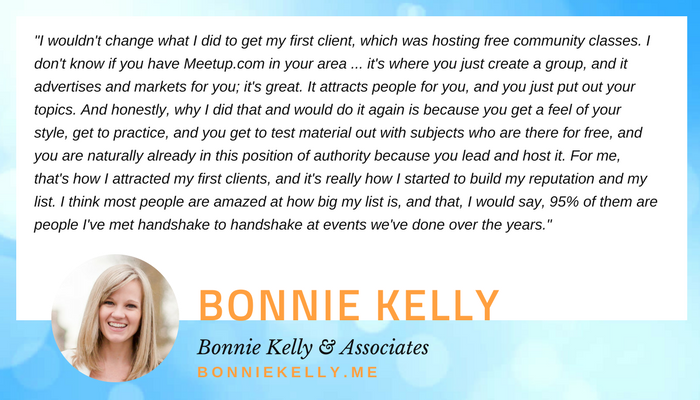
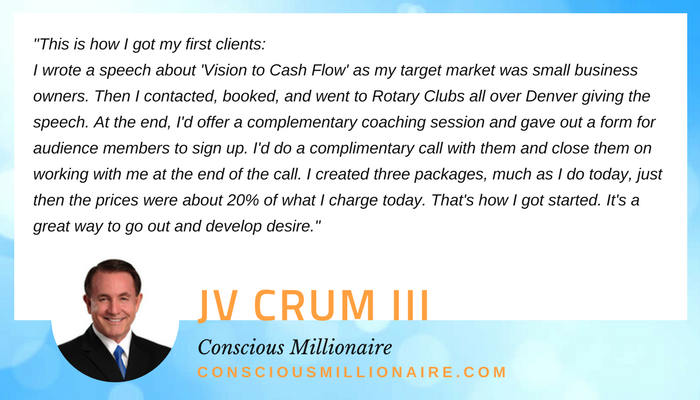
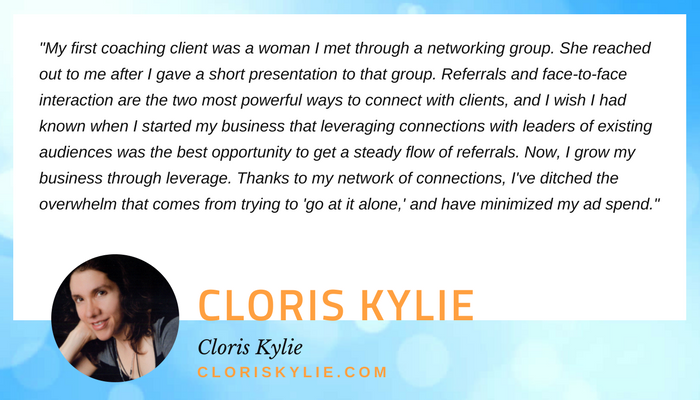
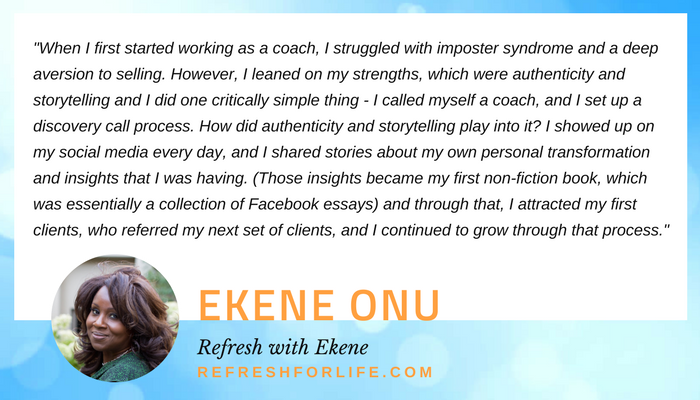
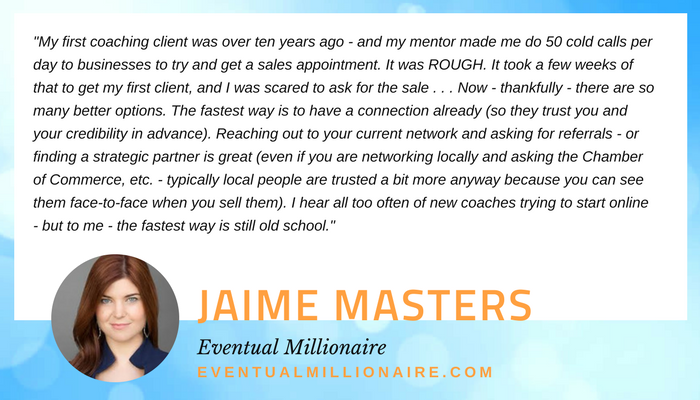
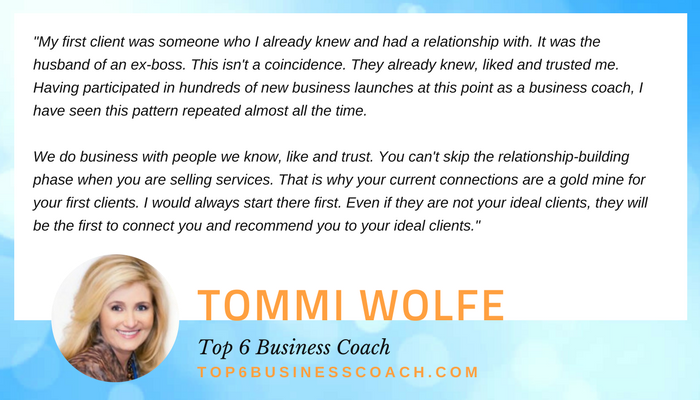

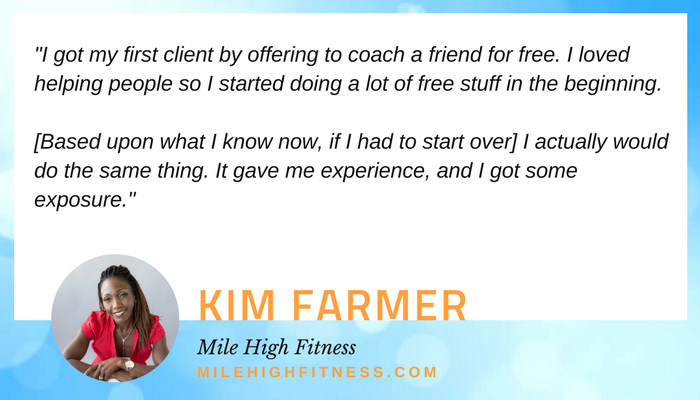

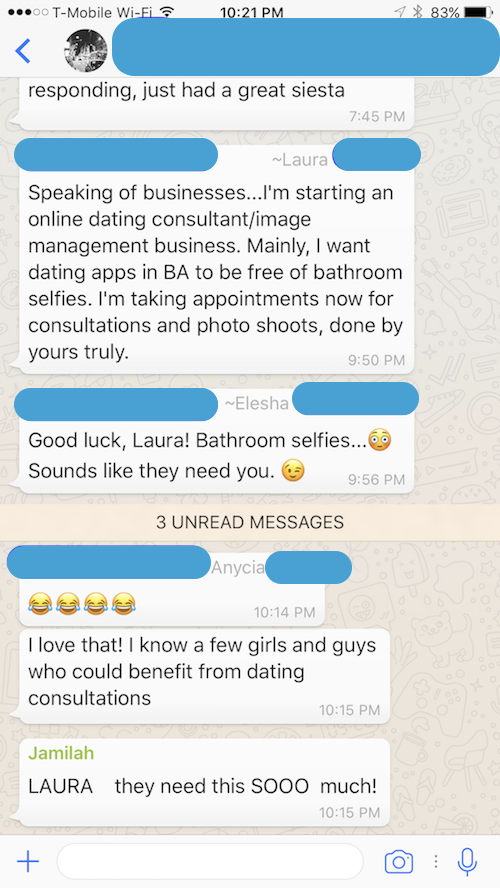
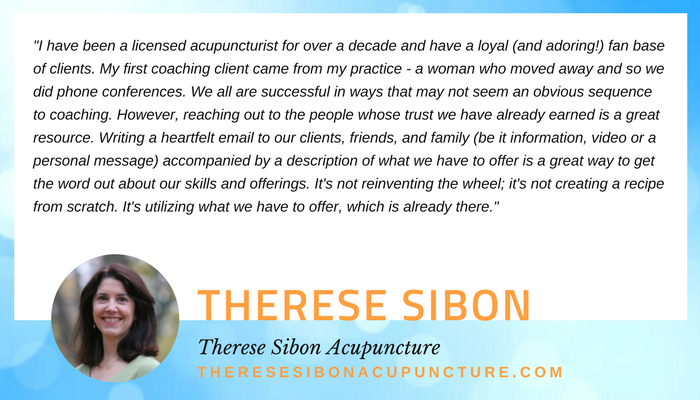
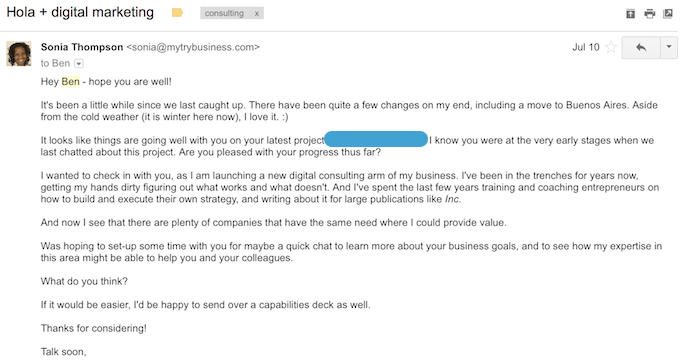
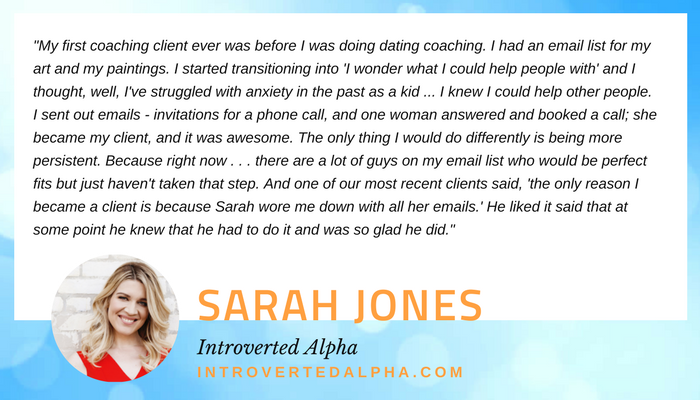
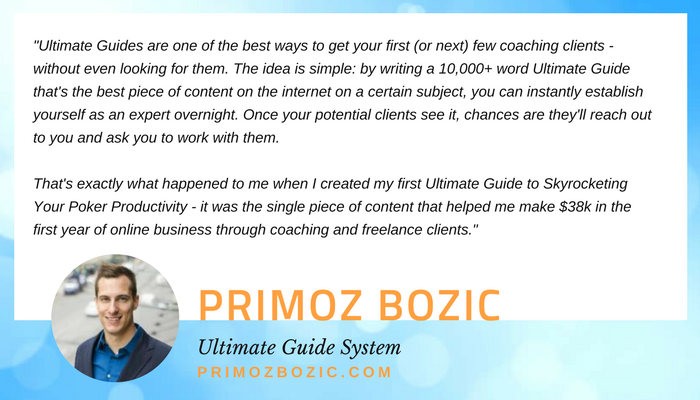
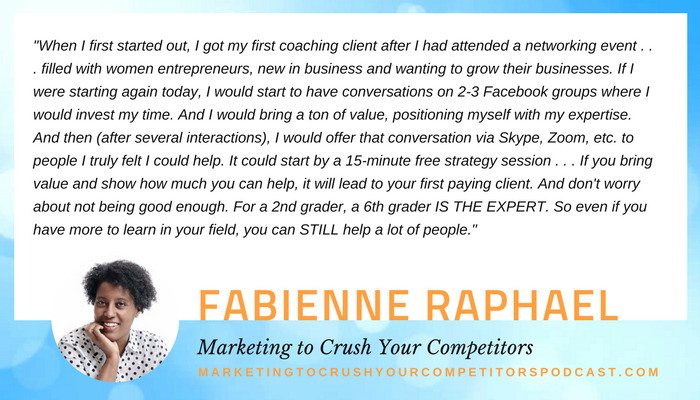
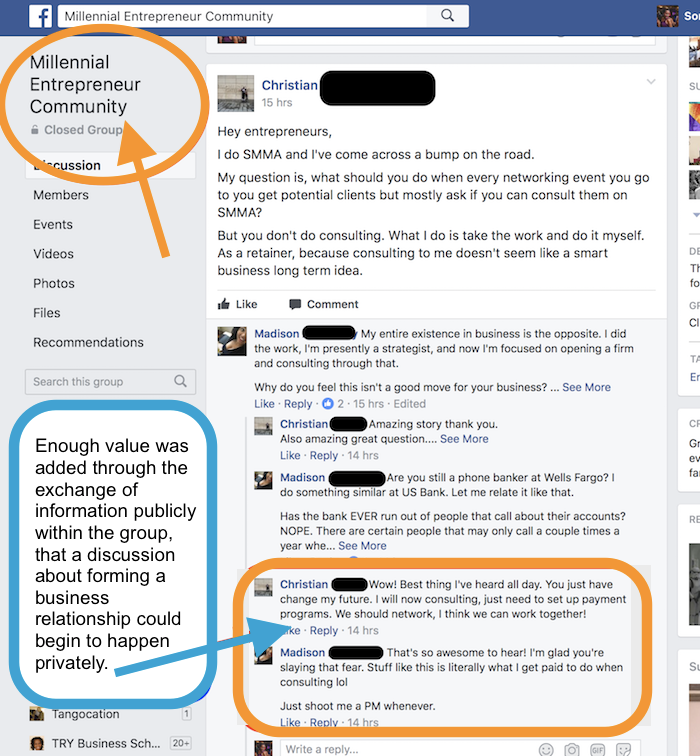
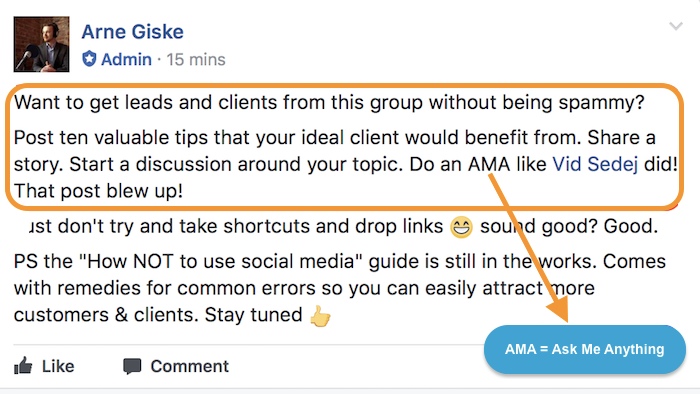
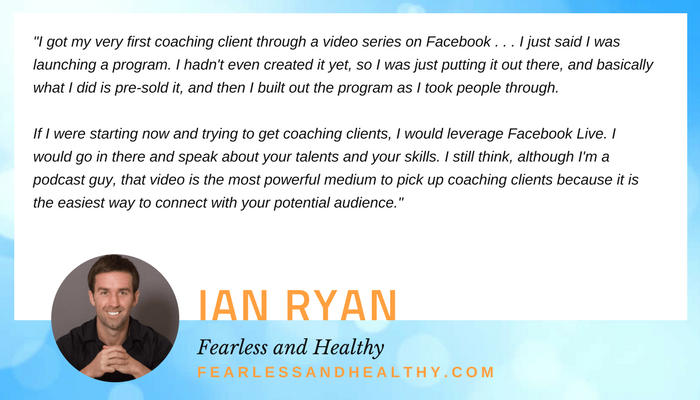
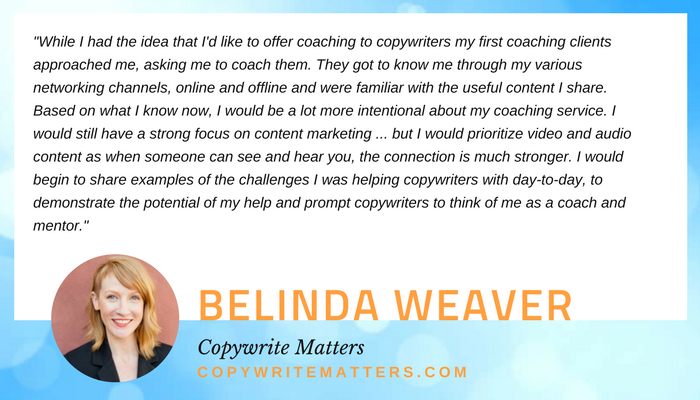
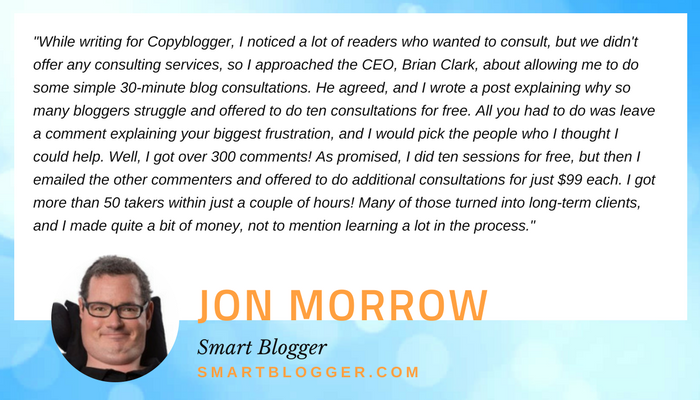
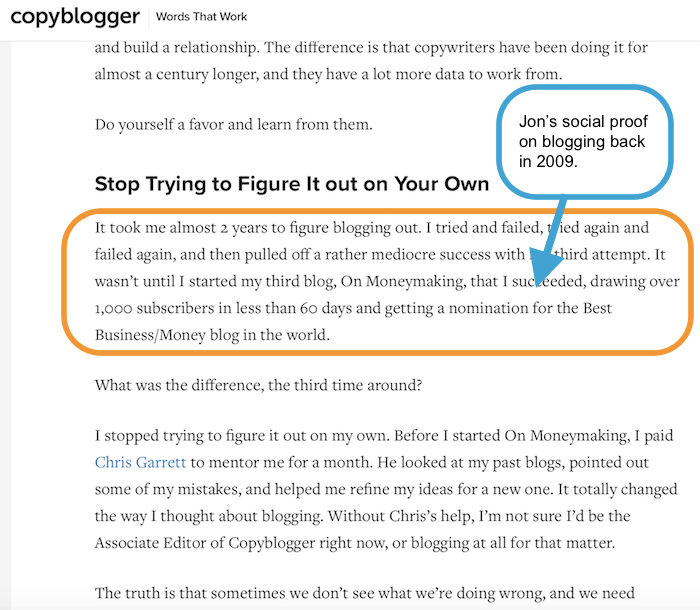




Lots of great info here! Thanks for sharing! I understand the need to basically start a coaching business by initially doing it for free, but how exactly do you transition over to getting paid? How do you tell that family member or close friend, whom you’ve been “practicing” your coaching on, that you need to get paid for the help you’re giving them? When people approach you for help as friend, and you give that initial help for free, how do you segue smoothly into a more professional role without ruining the helping relationship that’s been established? When/where is the line between free help and paid help, and how do you cross into the paid realm without sounding pushy or squelching their interest in your help, or worse, leaving them with thinking you’re not a genuine friend?
Hey Raylene – so glad you enjoyed the post.
If you decide to start out offering your services for free, just make sure to set the parameters up front, so those who are on the receiving end know it is for a limited time. For instance, you could say “I can give you 3 sessions for free, and if you’re interested in more after that, it will cost XX.” That gets them started with no risk, it gives you experience, and it sets the expectation that you are on a path to get paid for your expertise.
What a bombshell of a post, Sonia: you rock!
As someone looking to start a coaching service on my blog, I found your post very enlightening.
Couldn’t come at a better time.
I would love to try out these tips on Facebook groups and see how it goes.
Thank you!
Thanks Cyrus! Best wishes to you with the Facebook groups – let us know how you make out. 🙂
Great post Sonia! And what a great offer of the free sessions – people should definitely snap those up 🙂
Thanks so much Miranda – hope you are well 🙂
Everyone and their dog has a coach these days!
I love these tips! As a new coach, I have used several of these strategies, but you have given me a couple of new ones to try. Thank you!
Glad you’ve got some new strategies to test out Lorraine! Yes, lots of people seem to have coaches these days. But that may just be a good sign that coaching works :).
Hi Sonia,
Good Information for Coaching service. I love to try these tips on my blog for coaching. Thanks for sharing this information with us.
My pleasure Raghunath – all the best to you!
Hi Sonia,
What an amazing post it is! In fact, I have a great experience in coaching some of my local people.
But, when it comes to having some people to coach online, I’m a newbie. By the way, now I think that I can dare to start a coaching business soon since you’ve provided a lot of tactics to do this.
So kind of you,
SM
Hey SM – congrats on getting this to work for you with the offline strategies. Since you’ve done well there, I’m sure you’ll find success with some of the online approaches too. Wishing you all the best with it! 🙂
Sonia, what an epic article! Enjoyed every bit of it, and I even got new ideas for my own coaching business. Thank you!
Thanks so much Cloris – and for sharing your experiences! Your insights totally helped shape the post. 🙂
WOW! Thorough, well-researched, thought and inspiration provoking! Loaded with great info. I’m in the process of taking a different approach to my coaching, and this is a perfect resource to save. Thank you for the perfection!
Hey Therese – thank you for providing insights into your process. It was super helpful in shaping the points here. All the best to you with the new changes in your practice – I’m sure you’re going to continue to rock it! 🙂
Hi Sonia,
Digging these tips.
I like being onstage, and feel that tip rocks as A1. If you share your services, clearly, you can land that first client.
Back in the day I used to hide away quite a bit. I barely charged peanuts. I recall someone sending me $25 for a couple of beers, a few years ago. Not long ago at all, really.
Turns out I was totally unclear on my services, my knowledge and overall insight because I had barely worked with clients before. When I did put myself out there with a clearer, more concise, coaching page, along with a more professional booking service, I felt clearer to raise my rates.
Now I promote my coaching services freely and signed up the most clients I’ve ever had this years. Onward and upward.
Ya gotta put yourself out there though – however uncomfortable – to sign up the first client. Create a transparent page sharing how you can help clients, with bullet point lists and goodness, mark the rates too. Easy way to find good matches and to release on non matches right away. Better for both parties.
Thanks for sharing the tips.
Ryan
Hey Ryan – congrats to you for putting yourself out there, and for seeing the corresponding results.
It isn’t always the most comfortable thing to do, but as you go out there, start talking to people with clarity about how you can help, the clients do come.
Keep going, but it sounds like you’re doing great already! 🙂
Ryan,
I know how good you feel to achieve that. It’s humbling starting from the bottom and getting there. I’m right behind you! 🙂
I just loved the article, very well written and totally complete, continue with the beautiful work.
Thanks Arlete – glad you enjoyed it 🙂
Getting clients involves strategic thinking and a long term vision where you desire to be as a thought driven leader. I once considered consulting businesses but couldn’t juggle my time in between creating content and building up my own business. Perhaps some day I might get into consulting depending on how I feel about it.
I hope you do get back into it. It does require a bit of a split in time, for lead generation activities, in addition to doing the actual coaching, but you can make it work. 🙂
Sonia,
I absolutely agree. It’s all about the positive mindset and staying entrepreneurially focused. It’s a tough job, but someone has to do the transformation business work to be an inspiration to others! 🙂
Uhhh I red another brain revamping article at smartblogger again. This is very helpful. I had enough subscribers, but I never had the courage to start coaching, but you have helped me. I’m gonna start now.
You have everything you need to get started Awogor. Your subscribers have already raised their hands to learn from you. Go for it!
As you said a strategy is a must. Valuable points. Thank you.
my pleasure! 🙂
yeah, it is the best way to find the Coaching clients.
Thanks for sharing the Info article
Good luck. You have a good site
Hi Sonia Thompson.
If there is anything that I will be taking home from this blog post, is that I don’t need 1000 subscribers in my mail list to start a coaching business.
See, I am just starting out. And you know what?
My audience count is still low.
This post has really motivated me to go for what i have always wanted: A coaching Biz.
Once more, thanks.
You can do it Mathenge! Go for it! 🙂
It’s a great post! Because reading I’ve got an amazing idea for my business. Thank you!!!
Glad to hear it Santosh – thank you! 🙂
amazing post…..really one has to really work a lot to get the first coaching client…this post will always help anyone who is struggling to survive in the competitive market…!!
Many thanks Arvind – so glad you enjoyed it. Go get that 1st client!
This is a great guide, exceptionally very well explained.
Nice article and great concept. I have been planning a coaching tutorial on my blog too and i will be including a youtube channel too. It is really a great feeling when you pass information to your audience in a professional way. it builds trust and make you and authority overtime. I love the way you categorically explained the coaching idea here. Thanks for this eye opener. I love this.
Glad you enjoyed it Cyracks – all the best with that tutorial, sounds like its going to be fabulous! 🙂
From this post I really learned a lot. These tactics are really great! I have added it to my bookmarks.
Hi Sonia, Thanks for sharing these awesome tactics!
My pleasure! 🙂
Sonia you are splendid in the articles as always! each of them is very curious and interesting, whether you are in this world or not, you can see the experience you have, I love you! thank you very much for sharing it and I hope you continue like this, kisses from spain, here you also have fans, #TeamSonia
Jorge! thanks so much for your note and kind words. Saludos desde Argentina! Besos! 🙂
Hi Sonia,
You left no stone unturned. This is straight and powerful.
“I don’t have an email list” is a lame excuse people use to excuse themselves from their success.
I had no email list when I started coaching and I was doing very well without it.
But what gave me edge was that I maintained contact with members of the group I was in. Many came to know me and began to do business with me. Facebook group is a powerful thing.
Thanks for sharing.
Emmanuel
Glad you enjoyed it Emmanuel – and that things are working well for you. Keep going! 🙂
Every coach out of school needs to read this. Thank you for your honesty, 🙂
i think there is something wrong with this blog, when i open the webpages then first all content shows in right side and after 3 seconds all content moved to left site, i think there is some script conflicting in this site pages @Sonia Thompson & @admin please check it
Thank you, Ruby. I’ve sent your concerns to our IT guy.
Here are my 10 Tips for Getting Your First Client.
1. Identify your area of specialty – don’t be a generalist. …
2. Know your Ideal Client. …
3. Create your Elevator Speech. …
4. Let your Ideal Client get to know you better. …
5. Make it easy to do business with you. …
6. Connect with other coaches. …
7. Prepare a 20 minute speech around your topic.
8. Volunteer to coach 5 clients through a worthy organization – get testimonials and referrals.
9. Pitch yourself as a radio guest
10. Ask for the commitment.
Hi Sonia!
It’s 2020 but the issues you address for a new coach are still so relevant.
Working with coaches so far, we’ve seen this trend where they feel spending big on the website and branding and marketing will get them to the pinnacle first. But, that’s just fool’s gold.
Unless they are willing to dive deep into their niche, their services, and be all about their clients, they won’t get far; regardless of how flashy their website or marketing materials look.
Thank you once again for the in-depth article. Cheers!